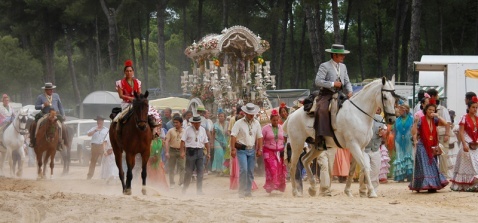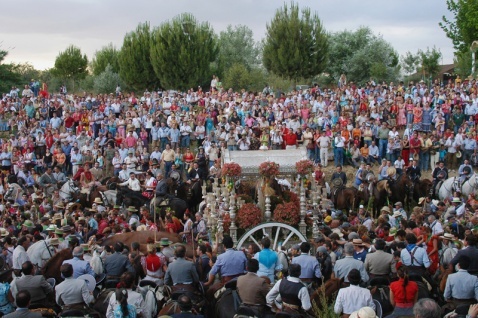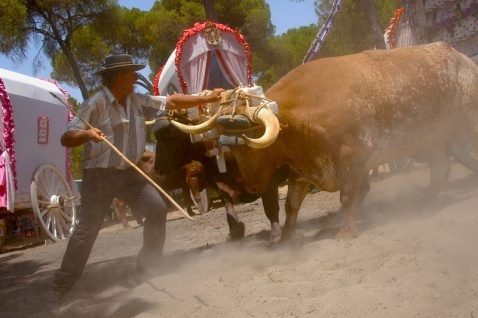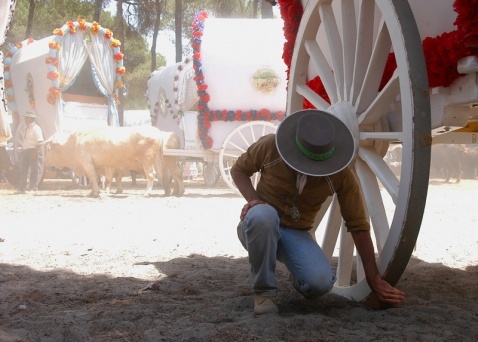
All the pilgrims share the same impulse of popular and sincere faith © Joaquin Alarcón |
|

The El Rocio Pilgrimage © Joaquin Alarcón |
|

The journey to El Rocio © Joaquin Alarcón |
|

An array of beautiful dresses © Joaquin Alarcón |
|

El Rocio © Joaquin Alarcón |
|
EL Rocio - A pilgrims tale
A lot of people go on a pilgrimage to El Rocio. Those who believe in heaven and those who don't. A few hours after starting along the paths of Lower Andalusia, a unique form of relation is established. Differences disappear. Hearts open. This is the miracle of El Rocio.
A lot of people go on a pilgrimage to El Rocio. Those who believe in heaven and those who don't. A few hours after starting along the paths of Lower Andalusia, a unique form of relation is… More →
The El Rocío pilgrimage is the most famous in the region, attracting nearly a million people from across Andalucia and the entire country, and beyond. Every Andalucian city, town and village has… More →
Andalucia is famous for its pilgrimages or "romerías" - so called because pilgrims traditionally walked to Rome, and therefore became known as "romeros" - to popular shrines, around which fiestas… More →
This is a strange outpost of the Wild West, with wide, sandy streets lined with houses complete with broad verandas and wooden rails for tying up horses. It is famous for its annual Romería, the … More →
Preparations
Thursday before Whit Sunday, eight in the morning. In the chapel of the narrow evangelista street of the Triana quarter in Sevilla, mass is coming to an end. Outside the pilgrims are getting organised. Men are wearing the borad brimmed Andalusian hat or light coloured cap. Women wear the traditional gypsy dress and have adorned their ponytails with small bunches of country flowers. All have at their neck, hanging from a wide green ribbon, a heavy silver medal. Once more their dream is coming true. They are going to the Rocio.
On the small square, two oxen ruminate hitched up to a small cart. Two large wooden wheels support a silver temple covered with flowers. A peal of bells announces the end of mass. Through the door comes out a standard which is going to form the heart of the pilgrimage. Totally embroidered with silver thread, the Simpecado has in the centre an effigy of the Virgen del Rocio (Our Lady of the Dew) whose richness awes me. Porcelain for the face and hands, gold for the whole body and an incredible quantity of precious stones are going to attest along the paths of Andalusia the intensity of an unbounded devotion. Firecrackers are let off. Marching to cries of "Viva la Reina de la Marisma" (Hurrah for the Marshes Queen) the procession sets off.
In the same manner, during the week some hundred "brotherhoods" leave the towns and villages of Andalusia. Their goal and their hope are identical. To keep the promise to go on the pilgrimage as far as the village of El Rocio, "ver a la Virgen" (to see the Virgin) to pray before Her, everything started in the fifteenth century when a hunter found a statue of the Virgin Mary in a tree trunk. The place: the marshes of the Guadalquivir, very close to the present national park of the Coto Donana. At first devotion was limted to local villages, Villlamanrique where the hunter lived and Almonte which soon made the Virgin its patron saint. In the nineteenth and even more in the twentieth century, it extended itself to the Triana quarter in Sevilla and then to the whole of Andalusia, to Madrid, to Barcelona, to the Canaries.. A devotion which lives on the spontaneity of the Andalusian sense of style and merry making and gets to the bottom of souls without distinction of classes.
"Arenal Fishmarket, Isable communicates to her customers that her shop will be closed until next Monday owing to the accompaniment of the miraculous Simpecado of the Triana Rocio Brotherhood". If every person going to the Rocio these days were to put an ad in the paper, the ABC of Sevilla would look like a phone directory. Sevilla is getting empty. Sevilla is on its way to the Rocio. The Castilla street is turned into a long procession. The cart of the Simpecado leads the way. Behind, some ten women are keeping the promise of not letting go of it until they reach the village. They are followed by dozens of traditional ox carts covered with immaculate awnings drawn tight on large lavishly decorated hoops. Behing large lace or brilliantly coloured curtains, I catch sight of well pressed gypsy dresses. Underneath there is fodder and water for the animals. Behind comes a long caravan of tractors with wagons for the pilgrims to live in a completely self sufficient way during one week. Platforms on wheels usually used for work in the fields have been caovered with awnings. At the lower level is a large mattress for the men Above, another one for the women. In the front part, a galley with an icebox and barrel with a machine for cool beer. Dresses and hams hand from the ceiling. Some even have a shower.
off we go
This year I have been fortunate, Maria Jose and Francisco have invited me. "Hacen el camino" (they do the Way) every year with a group of friends. We walk at ox pace. Many people go on horseback. On the first day, we go out of Sevilla. At night, in a pine forest, carts and wagons are place in a large circle. In the centre, the Simpecado. A meditative mood reigns by candlelight. All the pilgrims gather to say the rosary. Emotion. Little by little we are freeing ourselves of the mask imposed upon us by city life.
 |
| Discover the magic of El Rocio |
The night has been quiet. Dawn wakes up to the sound of firecrackers. The oxen are hitched up again to the yoke. Carts are being loaded. It feels chilly. We cover our gypsy dresses with wool ponchos. The caravan is now passing through golden plots of sunflowers, olive and pine trees. We are in another world. Magic of the country flowers. Magic of the perfumes. Magic of the light. Magic of the reunion with life… The sun exalts the smells of pine and eucalyptus, plays with the transparent shade of the dust lifted by boots and horse hooves, causes the precious metals to shine, puts a ring of light around the Virgin's face. Along the way, hearts open. Barriers fall. All the pilgrims share the same impulse of popular and sincere faith. Juan a twenty year old farmhand is wearing two medals. "A firend of mine could not come this year. He asked me to wear his as well". Antonia is a seamstress, she made herself six skirts for the occasion. "You will see her eyes. Last year I had a lot of things to ask Her but in front of Her I forgot everything. I was happy". Fredrico is an architect. "Along the way, I forget all my problems. I am walking with Her. I feel good".
Along the way, time is given by the sun. When it reaches its zenith, when boots start to feel heavy of walking in the sand, it is time to stop and bring out some prawns, cut a few slices of ham and fry a little fish. After siesta we come to the famous Quema, a ford in the Guadiamar river, the River Jordan of the Rocio. In the middle of the stream the oxen drink in long draughts. Maria Jose shows me what all women do: take up their skirts in their belts. She gives me a basket. It is full of petals. A multicoloured rain falls on the Simpecado. The pilgrims sing a hymn to the Virgin. Filling his hat with water, a man christens all those who are going to the Rocio for the first time. I did not expect it. I am thoroughly wet, but happy.
An hour later, the procession comes into the village of Villamanrique. The riders sit upright in their saddle, the walkers strike boots and trousers to take of the dust, the women touch up their makeup. Here tradition has set a milestone. In front of the church, the oxen take a run up. The large wheels of the Simpecado's cart jump six steps at one go. Inside homage is paid to the first of the filial brotherhoods. Slowly, helped by pilgrims and local folk, the animals and their precious charge come down backwards, applauded by the multitude of spectators. The cattleman is not the only one who wipes a tear from his cheek.
At night, fires, songs and dances are back… At dawn, more walking in the sand, stifling heat and the expectation to Her again…Once the "frontier" of the Ajoli wooden bridge is crossed, we are in the Rocio. There is no time to lose. Our group is one of the last to get there and this same morning at twelve o'clock, all brotherhoods have to present themselves before the Almonte "Mother Brotherhood". In the village which passes in a few hours from a hundred to more than a million inhabitants, there is general rejoicing.
Whit Sunday
The longest and most glorious day of the pilgrimage starts on Whit Sunday with pontifical mass on the huge esplanade. At night, for the rosary, all brotherhoods with standards and drums accompany their Simpecado in a marvellous procession by candlelight. In a few hours, at dawn, the Virgin is to come out of the sanctuary. Men from the village of Almonte, impatient, are already clinging to the railings which surround the statue. A priest tries to prolong the wait with the singing of hymns. Finally, at one forty, Faustinio, an almonteno, can't take any more. He jumps over the railings followed by a crowd of village men. A sea of arms lifts the float. The gate opens. Very rapidly the Virgin gets to the main entrance and rushed forward out of the church greeted by a peal of bells. Thousands of firecrackers light up the sky. The Virgin runs over a human sea. Stops. Falls over. Sinks….Saved from wrecking at the last second. She moves again. Backwards to the right, to the left…The crowd cheers. Exhausted, sweating as if out of his mind, any almonteno who comes from under the float is immediately substitued by ten volunteers. Everyone wants to touch her. Children are lifted towards the float. At the beginning of the afternoon, the Virgin goes back to her basilica. She has been more than twelve hours outdoors. In El Rocio no one has slept. As if waking up form a dream everyone realises that it is Monday. Six thousand pilgrims start on their way back. Adios Maria Jose, Adios Francisco. Adios…Next year will soon be here…Viva la Virgen del Rocio.
Article first published in the Andalucia Costa del Sol, Magazine.